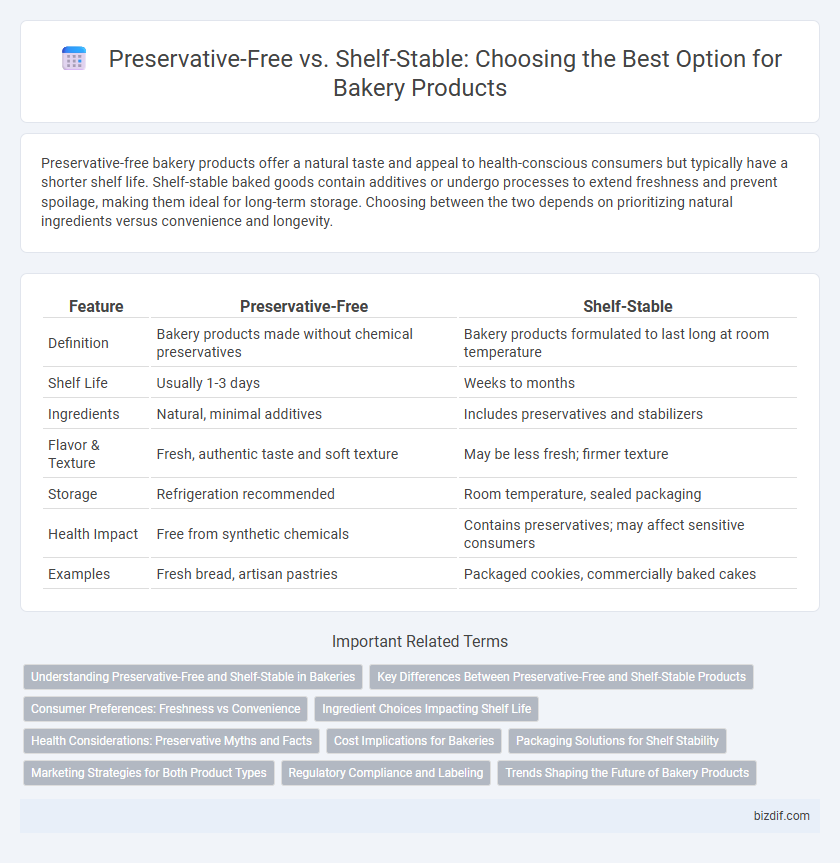Preservative-free bakery products offer a natural taste and appeal to health-conscious consumers but typically have a shorter shelf life. Shelf-stable baked goods contain additives or undergo processes to extend freshness and prevent spoilage, making them ideal for long-term storage. Choosing between the two depends on prioritizing natural ingredients versus convenience and longevity.
Table of Comparison
| Feature | Preservative-Free | Shelf-Stable |
|---|---|---|
| Definition | Bakery products made without chemical preservatives | Bakery products formulated to last long at room temperature |
| Shelf Life | Usually 1-3 days | Weeks to months |
| Ingredients | Natural, minimal additives | Includes preservatives and stabilizers |
| Flavor & Texture | Fresh, authentic taste and soft texture | May be less fresh; firmer texture |
| Storage | Refrigeration recommended | Room temperature, sealed packaging |
| Health Impact | Free from synthetic chemicals | Contains preservatives; may affect sensitive consumers |
| Examples | Fresh bread, artisan pastries | Packaged cookies, commercially baked cakes |
Understanding Preservative-Free and Shelf-Stable in Bakeries
Preservative-free bakery products rely on natural ingredients and faster turnover to maintain freshness, appealing to health-conscious consumers seeking clean labels. Shelf-stable baked goods use additives or specific packaging techniques to extend product longevity without refrigeration, ensuring consistent availability and reducing waste. Understanding the balance between preservative-free appeal and shelf stability is crucial for bakeries aiming to meet diverse customer demands while maintaining product safety and quality.
Key Differences Between Preservative-Free and Shelf-Stable Products
Preservative-free bakery products rely on natural ingredients and short shelf life to ensure freshness, often requiring refrigeration or quick consumption. Shelf-stable bakery items contain additives or undergo processing techniques, such as dehydration or vacuum sealing, to maintain quality and safety without refrigeration for extended periods. Understanding these differences helps consumers choose between fresher goods with limited longevity and longer-lasting products designed for convenience and storage.
Consumer Preferences: Freshness vs Convenience
Consumers often prioritize freshness in bakery products, favoring preservative-free options that deliver natural taste and texture. Shelf-stable baked goods appeal to busy individuals seeking convenience and longer storage without refrigeration. Balancing freshness with convenience influences purchasing decisions, shaping product offerings in the bakery market.
Ingredient Choices Impacting Shelf Life
Preservative-free bakery products rely on natural ingredients like sourdough starter, vinegar, and salt to inhibit microbial growth, resulting in shorter shelf life but cleaner labels. Shelf-stable baked goods incorporate ingredients such as calcium propionate, sodium benzoate, or modified starches that extend freshness and moisture retention without refrigeration. Ingredient choices directly influence microbial stability, texture, and flavor preservation, balancing consumer demand for naturalness against commercial shelf life requirements.
Health Considerations: Preservative Myths and Facts
Preservative-free bakery products often appeal to health-conscious consumers seeking natural ingredients, but the absence of preservatives does not guarantee superior nutritional value or safety. Shelf-stable baked goods use approved preservatives that inhibit mold and bacterial growth, extending shelf life without compromising health when consumed within recommended limits. Understanding that not all preservatives are harmful helps dispel myths, as many synthetic and natural preservatives undergo rigorous testing to ensure they meet safety standards established by regulatory bodies like the FDA.
Cost Implications for Bakeries
Preservative-free bakery products often incur higher production costs due to the need for fresh ingredients and shorter shelf life, leading to increased waste and more frequent baking cycles. Shelf-stable baked goods reduce costs by extending product longevity, decreasing the frequency of production and distribution expenses while minimizing spoilage losses. Bakeries must balance the premium of preservative-free appeal against the economic efficiency of shelf-stable options to optimize profitability.
Packaging Solutions for Shelf Stability
Shelf-stable bakery products rely on advanced packaging solutions such as vacuum sealing, modified atmosphere packaging (MAP), and oxygen absorbers to extend freshness without preservatives. These methods effectively inhibit microbial growth and oxidation, maintaining product quality over prolonged periods. Innovative materials like multi-layer laminates and moisture barrier films enhance shelf life by protecting against environmental factors.
Marketing Strategies for Both Product Types
Marketing preservative-free bakery products emphasizes authenticity, natural ingredients, and health benefits to attract health-conscious consumers seeking fresh, clean-label options. Shelf-stable bakery goods leverage convenience, extended freshness, and reliable quality, targeting busy customers and retailers needing long-lasting inventory. Tailored messaging for each product type highlights unique selling points, aligning with specific consumer values and purchasing behaviors to maximize market appeal.
Regulatory Compliance and Labeling
Preservative-free bakery products must comply with strict regulatory guidelines that mandate clear labeling to inform consumers about the absence of synthetic additives, ensuring transparency and safety. Shelf-stable baked goods require adherence to food safety standards that permit the use of approved preservatives or specific processing techniques to extend shelf life while maintaining product stability. Accurate labeling for both categories is essential to meet FDA and international food safety regulations, helping consumers make informed choices based on ingredient content and shelf life expectations.
Trends Shaping the Future of Bakery Products
Preservative-free bakery products cater to growing consumer demand for clean labels and natural ingredients, driving innovation in ingredient sourcing and processing techniques. Shelf-stable baked goods leverage advanced packaging technologies and formulations to extend freshness without artificial additives, meeting the needs of convenience and longer shelf life. Trends indicate a balanced integration of preservative-free formulations with shelf-stable features, reshaping product development and market strategies in the bakery industry.
Preservative-Free vs Shelf-Stable Infographic

 bizdif.com
bizdif.com